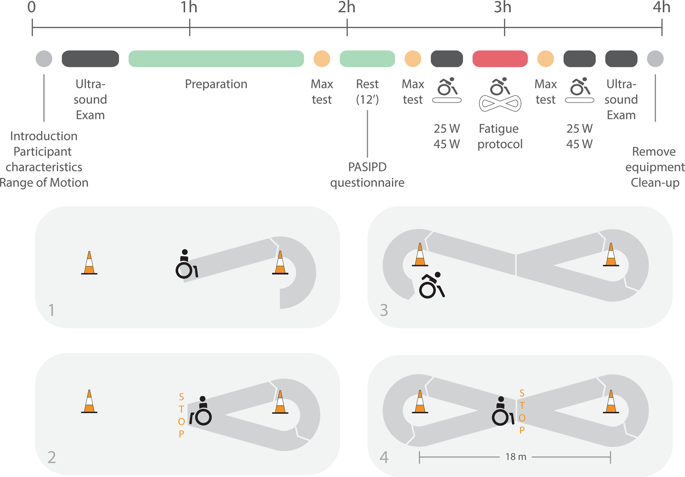当前位置:
X-MOL 学术
›
Spinal Cord
›
论文详情
Our official English website, www.x-mol.net, welcomes your
feedback! (Note: you will need to create a separate account there.)
Changes in supraspinatus and biceps tendon thickness: influence of fatiguing propulsion in wheelchair users with spinal cord injury.
Spinal Cord ( IF 2.1 ) Pub Date : 2019-11-19 , DOI: 10.1038/s41393-019-0376-z Fransiska M Bossuyt 1, 2 , Michael L Boninger 3, 4, 5, 6 , Ann Cools 7, 8 , Nathan Hogaboom 9, 10 , Inge Eriks-Hoogland 11 , Ursina Arnet 1, 2 ,
Spinal Cord ( IF 2.1 ) Pub Date : 2019-11-19 , DOI: 10.1038/s41393-019-0376-z Fransiska M Bossuyt 1, 2 , Michael L Boninger 3, 4, 5, 6 , Ann Cools 7, 8 , Nathan Hogaboom 9, 10 , Inge Eriks-Hoogland 11 , Ursina Arnet 1, 2 ,
Affiliation

|
STUDY DESIGN
A quasi-experimental, pretest-posttest design.
OBJECTIVES
To identify acute changes in the supraspinatus and biceps tendon following fatiguing wheelchair propulsion and to associate tendon changes with risk factors associated with shoulder pain in persons with spinal cord injury (SCI).
SETTING
Biomechanical laboratory Swiss Paraplegic Research.
METHODS
A population-based sample of 50 wheelchair users with SCI at lesion level T2 or below participated. Fatigue was measured by using the rate of perceived exertion and heart rate. Linear regression techniques were used to assess the association between the dependent and independent variables. Dependent variables included absolute differences in supraspinatus and biceps tendon thickness, contrast, and echogenicity ratio assessed with ultrasound before and after a fatiguing wheelchair propulsion intervention. Independent variables included susceptibility to fatigue (Yes/No), the acromio-humeral distance, sex, time since injury, activity levels, and body weight.
RESULTS
A reduction in supraspinatus tendon thickness after fatiguing wheelchair propulsion (-1.39 mm; 95% CI: -2.28; -0.51) was identified after controlling for all potential confounders. Females who fatigued (n = 4) displayed a greater reduction in supraspinatus tendon thickness as compared with those who did not fatigue (n = 7). In contrast, higher body weight was associated with an increase in supraspinatus tendon thickness and a greater acromio-humeral distance before the intervention was associated with an increase in biceps tendon thickness.
CONCLUSIONS
Acute changes in the supraspinatus and biceps tendon after fatiguing wheelchair propulsion may explain the high prevalence of tendon injuries in this population. Future research should determine the consequences of tendon changes and its relationship to tendinopathy.
中文翻译:

棘上肌和二头肌肌腱厚度的变化:疲劳性推进对脊髓损伤轮椅使用者的影响。
研究设计准实验,前测后测设计。目的确定疲劳性轮椅推进后棘上肌和二头肌肌腱的急性变化,并将肌腱变化与脊髓损伤(SCI)患者肩痛相关的危险因素联系起来。设置生物力学实验室瑞士截瘫研究。方法以人口为基础的50名S2级或以下病灶的SCI轮椅使用者参加了调查。通过使用感知的劳累率和心率来测量疲劳。线性回归技术用于评估因变量和自变量之间的关联。因变量包括棘上肌和二头肌肌腱厚度的绝对差异,对比,在疲劳轮椅推进干预前后,通过超声评估回声率。自变量包括疲劳易感性(是/否),肩肱距离,性别,受伤时间,活动水平和体重。结果在控制了所有潜在的混杂因素后,确定了疲劳轮椅推进后脊上肌腱厚度的减少(-1.39 mm; 95%CI:-2.28; -0.51)。与没有疲劳的女性(n = 7)相比,疲劳的女性(n = 4)表现出棘上肌腱厚度的更大减少。相反,在干预与肱二头肌肌腱厚度增加相关之前,较高的体重与肱骨上肌腱厚度增加以及较大的肩肱距离相关。结论疲劳性轮椅推进后棘上肌和二头肌肌腱的急性变化可能解释了该人群肌腱损伤的高发率。未来的研究应确定肌腱变化的后果及其与肌腱病的关系。
更新日期:2019-11-20
中文翻译:

棘上肌和二头肌肌腱厚度的变化:疲劳性推进对脊髓损伤轮椅使用者的影响。
研究设计准实验,前测后测设计。目的确定疲劳性轮椅推进后棘上肌和二头肌肌腱的急性变化,并将肌腱变化与脊髓损伤(SCI)患者肩痛相关的危险因素联系起来。设置生物力学实验室瑞士截瘫研究。方法以人口为基础的50名S2级或以下病灶的SCI轮椅使用者参加了调查。通过使用感知的劳累率和心率来测量疲劳。线性回归技术用于评估因变量和自变量之间的关联。因变量包括棘上肌和二头肌肌腱厚度的绝对差异,对比,在疲劳轮椅推进干预前后,通过超声评估回声率。自变量包括疲劳易感性(是/否),肩肱距离,性别,受伤时间,活动水平和体重。结果在控制了所有潜在的混杂因素后,确定了疲劳轮椅推进后脊上肌腱厚度的减少(-1.39 mm; 95%CI:-2.28; -0.51)。与没有疲劳的女性(n = 7)相比,疲劳的女性(n = 4)表现出棘上肌腱厚度的更大减少。相反,在干预与肱二头肌肌腱厚度增加相关之前,较高的体重与肱骨上肌腱厚度增加以及较大的肩肱距离相关。结论疲劳性轮椅推进后棘上肌和二头肌肌腱的急性变化可能解释了该人群肌腱损伤的高发率。未来的研究应确定肌腱变化的后果及其与肌腱病的关系。











































 京公网安备 11010802027423号
京公网安备 11010802027423号